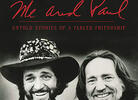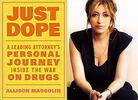
Best known for his The Six-Word Memoir Project and book series, Larry Smith has teamed up with University of California at Berkeley professor and novelist Melanie Abrams on The Joy of Cannabis, a hardcover that offers "75 Ways to Amplify Your Life Through the Science and Magic of Cannabis."
The release date for The Joy of Cannabis (Sourcebooks, $29.99) is Jan. 10, when the authors will be appearing at Mrs. Dalloway's in Berkeley, CA for a reading and Q&A at 7 pm. See their tour schedule below.
Smith and Abrams answered the following questions provided by CelebStoner.
What inspired you to write this book?
We met three years ago at a party in the Bay Area. We started talking and when Melanie asked the circle of folks in the room, “Does anyone want to go out to the deck and get high?” Larry said yes, and we began a conversation that hasn’t stopped. Along the way, we realized we loved cannabis for the same reasons: this magical flower unlocks creativity and connection, decreases inhibitions and helps you be gloriously in the moment. And soon after we started working on the book, friends, friends of friends and parents of friends began flooding us with questions: Can cannabis assist with my anxiety? Pain? Sleep? Will it help reconnect me with my partner, parents and long lost friends? Do people really get more focused and productive with edibles? What’s the best way to use cannabis? How do I navigate a dispensary? Why do you call it "cannabis" and not "marijuana”?
How does The Joy of Cannabis differ from other weed-related books?
There are lots of books on cannabis, as well as blogs, web magazines and podcasts. Most focus on a specific lane — growing, selling, the industry, legislation, equity, strains and more. We love much of this media but wanted to write a book that would be a warm welcome for the canna-curious and still offer some new ideas and insight for canna-connoisseurs. We think of The Joy of Cannabis as “the internet in a box” in the form of a technology that still works really well: a book! Our book is a mix of “how to” toolkit, sober science and playful activities that allow readers to unlock the mind and body, increase productivity and, above all, joy. We have robust sections on music, sex and food. We also address timely issues around equity and inclusion and the importance of supporting BIPOC-owned canna-businesses.
RELATED: Five Questions with "Branding Bud" Author David Paleschuck
The press release refers to the "Golden Age of Cannabis." What does that mean?
The Golden Age of Cannabis is when in 37 states, people can walk into a dispensary and get recommendations from professionals about the best delivery systems, the best strains and the best products for their particular bodies. It’s when New York’s first recreational dispensary license goes to Housing Works, a nonprofit that supports people living with HIV and AIDS. It’s when some of our top chefs are integrating cannabis into their menus to elevate taste buds and minds. It’s when our parents are asking for cannabis recommendation for nausea and sleep. It’s when, slowly but surely, the stigma of the “slacker stoner” is rapidly leaving the building and millions of people are awakening to the powers of the ancient flower to make music more beautiful, food more delicious and sex even sexier. No age is truly “golden” — there’s a lot of work that needs to be done around equity and inclusion and overturning years of racist laws — but we are on the right track.
The releaase also says, "You'll learn why the word marijuana rarely appears in this book." What’s wrong with using the word marijuana?
We prefer the flower’s original name, cannabis, for a few reasons. Cannabis has always been “cannabis,” going back thousands of years, but it was rebranded “marihuana,” the Spanish word for cannabis by Harry Anslinger who, in 1930, became the first Commissioner of the Treasury Department’s newly formed Federal Bureau of Narcotics. His racist and xenophobic beliefs coincided with the immigration of tens of thousands of Mexicans which escalated many Americans' anti-Mexican sentiments. Anslinger used “marijuana” rather than the already widely used “cannabis.” Why? So white Americans would associate cannabis and its purported violent side effects with Mexicans. So, on the hardworking backs of those fighting the good fight for this glorious plant, we too are weeding out the word “marijuana,” with its racist origins, in favor of the scientific term, “cannabis.”
What are your favorite consumption methods?
Smith: Trial and luckily a limited amount of error has revealed that edibles work best for me. I like to start low and go slow, as the saying goes, and have a pretty good idea of how many milligrams to take depending on my setting.
Abrams: All flower, all the time. Despite knowing that cannabis has become so inbred that there’s a good chance what you think is a sativa or an indica is really a hybrid, I’m at heart a sativa girl. And, if I had to choose one strain to smoke for the rest of my life, it would be Durban Poison.

The Joy of Cannabis Tour Schedule
• Jan. 10: Mrs. Dalloway's, Berkeley, CA
• Jan. 11: Green Apple Books on the Park, San Francisco, CA
• Jan. 14: Barnes & Noble at the Grove, Los Angeles, CA
• Jan. 18: Sausalito Books by the Bay, Sausalito, CA
• Jan. 20: Copperfield's Books, Sebastopol, CA
• Jan. 24: Boulder Book Store, Boulder, CO
• Jan. 25: Tattered Cover, Denver, CO






